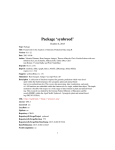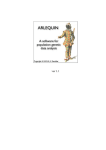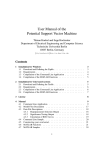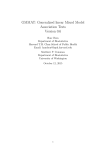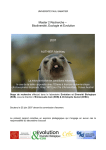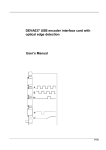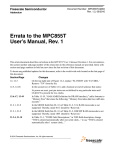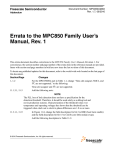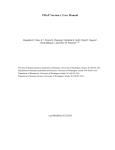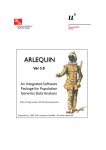Download Package `synbreed`
Transcript
Package ‘synbreed’ September 26, 2012 Type Package Title Framework for the analysis of genomic prediction data using R Version 0.9-4 Date 2012-09-18 Author Valentin Wimmer, Theresa Albrecht, Hans-Juergen Auinger, Chris-Carolin Schoen with contributions by Larry Schaeffer, Malena Erbe, Ulrike Ober and Christian Reimer Depends R (>= 2.14), lattice, igraph0, MASS, LDheatmap, qtl, doBy, BLR, regress (>= 1.38), abind, synbreedData (>= 1.3) Maintainer Valentin Wimmer <[email protected]> Description The package was developed within the Synbreed project for synergistic plant and animal breeding (www.synbreed.tum.de). It contains a collection of functions required for genomic prediction in both plant and animal breeding. This covers data processing, data visualization and analysis. All functions are embedded within the framework of a single, unified data object. The implementation is flexible with respect to a wide range of data formats. This research was funded by the German Federal Ministry of Education and Research (BMBF) within the AgroClustEr Synbreed - Synergistic plant and animal breeding (FKZ 0315528A). URL http://synbreed.r-forge.r-project.org/ License GPL-2 LazyLoad yes LazyData no ZipData no R topics documented: add.individuals add.markers . . codeGeno . . . create.gpData . create.pedigree crossVal . . . . . . . . . . . . . . . . . . . . . . . . . . . . . . . . . . . . . . . . . . . . . . . . . . . . . . . . . . . . . . . . . . . . . . . . . . . . . . . . . . . . . . . . 1 . . . . . . . . . . . . . . . . . . . . . . . . . . . . . . . . . . . . . . . . . . . . . . . . . . . . . . . . . . . . . . . . . . . . . . . . . . . . . . . . . . . . . . . . . . . . . . . . . . . . . . . . . . . . . . . . . . . . . . . . . . . . . . . . . . . . . . . . . . . . . . . . . 2 . 3 . 5 . 8 . 11 . 12 2 add.individuals discard.markers . . . . . . . gpData2cross . . . . . . . . gpData2data.frame . . . . . gpMod . . . . . . . . . . . . kin . . . . . . . . . . . . . . LDDist . . . . . . . . . . . LDMap . . . . . . . . . . . manhattanPlot . . . . . . . . MME . . . . . . . . . . . . pairwiseLD . . . . . . . . . plot.LDdf . . . . . . . . . . plot.LDmat . . . . . . . . . plot.pedigree . . . . . . . . plot.relationshipMatrix . . . plotGenMap . . . . . . . . . plotNeighbourLD . . . . . . predict.gpMod . . . . . . . . simul.pedigree . . . . . . . . simul.phenotype . . . . . . . summary.cvData . . . . . . summary.gpData . . . . . . summary.gpMod . . . . . . summary.pedigree . . . . . . summary.relationshipMatrix summaryGenMap . . . . . . write.beagle . . . . . . . . . write.plink . . . . . . . . . . write.relationshipMatrix . . [.GenMap . . . . . . . . . . [.relationshipMatrix . . . . . . . . . . . . . . . . . . . . . . . . . . . . . . . . . . . . . . . . . . . . . . . . . . . . . . . . . . . . . . . . . . . . . . . . . . . . . . . . . . . . . . . . . . . . . . . . . . . . . . . . . . . . . . . . . . . . . . . . . . . . . . . . . . . . . . . . . . . . . . . . . . . . . . . . . . . . . . . . . . . . . . . . . . . . . . . . . . . . . . . . . . . . . . . . . . . . . . . . . . . . . . . . . . . . . . . . . . . . . . . . . . . . . . . . . . . . . . . . . . . . . . . . . . . . . . . . . . . . . . . . . . . . . . . . . . . . . . . . . . . . . . . . . . . . . . . . . . . . . . . . . . . . . . . . . . . . . . . . . . . . . . . . . . . . . . . . . . . . . . . . . . . . . . . . . . . . . . . . . . . . . . . . . . . . . . . . . . . . . . . . . . . . . . . . . . . . . . . . . . . . . . . . . . . . . . . . . . . . . . . . . . . . . . . . . . . . . . . . . . . . . . . . . . . . . . . . . . . . . . . . . . . . . . . . . . . . . . . . . . . . . . . . . . . . . . . . . . . . . . . . . . . . . . . . . . . . . . . . . . . . . . . . . . . . . . . . . . . . . . . . . . . . . . . . . . . . . . . . . . . . . . . . . . . . . . . . . . . . . . . . . . . . . . . . . . . . . . . . . . . . . . . . . . . . . . . . . . . . . . . . . . . . . . . . . . . Index add.individuals . . . . . . . . . . . . . . . . . . . . . . . . . . . . . . . . . . . . . . . . . . . . . . . . . . . . . . . . . . . . . . . . . . . . . . . . . . . . . . . . . . . . . . . . . . . . . . . . . . . . . . . . . . . . . . . . . . . . . . . . . . . . . . . . . . . . . . . . . . . . . . . . . . . . . . . . . . . . . . . . . . . . . . . . . . . . . . . . . . . . . . . . . . . . . . . . . . . . . . . . . . . . . . . . . . . . . . . . . . . . . . . . . . . . . . . . . . . . . . . . . . . . . . . . . . . . . . . . . . . . . . . . . . . . . . . . . . . . . . . . . . . . . . . . . . . . . . . . . . . . . . . . . . . . . . . . . . . . . . . . . . . . . . . . . . 15 16 18 20 22 25 26 27 28 30 32 33 34 35 36 37 38 40 41 42 43 43 44 45 45 46 47 48 50 50 51 Add new individuals to objects of class gpData Description This function extends an object of class gpData by adding new phenotypes, genotypes and pedigree. Usage add.individuals(gpData, pheno = NULL, geno = NULL, pedigree = NULL, covar = NULL, repl=NULL) Arguments gpData object of class gpData to be updated pheno data.frame with new rows for phenotypes with rownames indicating individuals. For repeated values the ID should be stored in a column with name "ID". geno matrix with new rows for genotypic data with rownames indicating individuals add.markers 3 pedigree data.frame with new rows for pedigree data covar data.frame with new rows for covar information with rownames indicating individuals repl The column of the pheno data.frame for the replicated measures. If the values are not repeated or this column is named "repl" this argument is not needed. Details colnames in geno, pheno and pedigree must match existing names in gpData object. Value object of class gpData with new individuals Author(s) Valentin Wimmer See Also add.markers, discard.individuals Examples # add one new DH line to maize data data(maize) newDHpheno <- data.frame(Trait=1000,row.names="newDH") # simulating genotypic data newDHgeno <- matrix(sample(c(0,1),ncol(maize$geno),replace=TRUE),nrow=1) rownames(newDHgeno) <- "newDH" # new pedigree newDHpedigree <- data.frame(ID="newDH",Par1=0,Par2=0,gener=0) # new covar information newDHcovar <- data.frame(family=NA,DH=1,tbv=1000,row.names="newDH") # add individual maize2 <- add.individuals(maize,newDHpheno,newDHgeno,newDHpedigree,newDHcovar) summary(maize2) add.markers Add new markers to an object of class gpData Description This function adds new markers to the element geno of an object of class gpData and updates the marker map. Usage add.markers(gpData, geno, map) 4 add.markers Arguments gpData object of class gpData to be updated geno matrix with new columns map data.frame with columns ’chr’ and ’pos’ for new markers Details rownames in argument geno must match rownames in the element geno object of class gpData. Value object of class gpData with new markers Author(s) Valentin Wimmer See Also add.individuals, discard.markers Examples # creating gpData object # phenotypic data pheno <- data.frame(Yield = rnorm(10,100,5), Height = rnorm(10,10,1)) rownames(pheno) <- 1:10 # genotypic data geno <- matrix(sample(c(1,0,2,NA),size=120,replace=TRUE, prob=c(0.6,0.2,0.1,0.1)),nrow=10) rownames(geno) <- 1:10 # genetic map map <- data.frame(chr=rep(1:3,each=4),pos=rep(1:12)) colnames(geno) <- rownames(map) <- paste("M",1:12,sep="") # as gpData object gp <- create.gpData(pheno,geno,map) # new data geno2 <- matrix(c(0,0,1,1,1,2,2,1,1,2,1,2,0,2,1,1,1,2,2,2),ncol=2) rownames(geno2) <- 1:10 map2 <- data.frame(pos=c(0.3,5),chr=c(1,2)) rownames(map2) <- colnames(geno2) <- c("M13","M14") # adding new markers gp2 <- add.markers(gp,geno2,map2) summary(gp2) summary(gp) codeGeno codeGeno 5 Recode genotypic data, imputation of missing values and preselection of markers Description This function combines all algorithms for processing of marker data within synbreed package. Raw marker data is a matrix with elements of arbitrary format (e.g. alleles coded as pair of observed alleles "A/T","G/C", ... , or by genotypes "AA", "BB", "AB"). The function is limited to biallelic markers with a maximum of 3 genotypes per locus. Raw data is recoded into the number of copies of the minor allele, i.e. 0, 1 and 2. Imputation of missing values can be done by random sampling from allele distribution, the Beagle software or family information (see details). Additional preselection of markers can be carried out according to the minor allele frequency and/or fraction of missing values. Usage codeGeno(gpData,impute=FALSE,impute.type=c("random","family", "beagle", "beagleAfterFamily","fix"), replace.value=NULL, maf=NULL, nmiss=NULL, label.heter="AB", keep.identical=TRUE, verbose=FALSE, minFam=5, showBeagleOutput=FALSE, tester=NULL, print.report=FALSE) Arguments gpData object of class gpData with arbitrary coding in element geno. Missing values have to be coded as NA. impute logical. Should missing value be replaced by imputing? impute.type character with one out of "fix", "random" , "family", "beagle", "beagleAfterFamily" (default = "random"). See details. replace.value numeric scalar to replace missing values in case impute.type="fix". maf numeric scalar. Threshold to discard markers due to the minor allele frequency (MAF). Markers with a MAF < maf are discarded, thus maf in [0,0.5]. If map in gpData is available, markers are also removed from map. nmiss numeric scalar. Markers with more than nmiss fraction of missing values are discarded, thus nmiss in [0,1]. If map in gpData is available, markers are also removed from map. label.heter This is either a scalar or vector of characters to identify heterozygous genotypes or a function returning TRUE if an element of the marker matrix is the heterozygous genotype. Defining a function is useful, if number of unique heterozygous genotypes is large, i.e. if genotypes are coded by alleles. If the heterozygous genotype is coded like "A/T","G/C", ... then label.heter="alleleCoding" can be used. Note that heterozygous values must be identified unambiguously by label.heter. Use label.heter=NULL if there are only homozygous genotypes, i.e. in DH lines, to speed up computation and restrict imputation to values 0 and 2. keep.identical logical. Should duplicated markers be kept? NOTE: From a set of identical markers (with respect to the non-missing alleles) the one with the smallest number of missing values is kept. For those with an identical number of missing values, the first one is kept and all others are removed. 6 codeGeno verbose logical. If TRUE verbose output is generated during the steps of the algorithm. This is useful to obtain numbers of discarded markers due to different criteria. For impute.type family and beagleAfterFamily, each family should have at least minFam members with available information for a marker to impute missing values according to the family. The default is 5. showBeagleOutput logical. Would you like to see the output of the Beagle software package? The default is FALSE. minFam tester This option is in testing mode at the moment. print.report logical. Should a file SNPreport.txt be generated containing further information on SNPs. This includes SNP name, original coding of major and minor allele, MAF and number of imputed values. Details Coding of genotypic data is done in the following order (depending on choice of arguments; not all steps are performed): 1. Discarding markers with fraction > nmiss of missing values 2. Recoding alleles from character/factor/numeric into the number of copies of the minor alleles, i.e. 0, 1 and 2. In codeGeno, in the first step heterozygous genotypes are coded as 1. From the other genotypes, the less frequent genotype is coded as 2 and the remaining genotype as 0. Note that function codeGeno will terminate with an error whenever more than three genotypes are found. 2.1 Discarding duplicated markers if keep.identical=FALSE before starting of the imputing step. From identical marker based on pairwise complete oberservations one is discarded randomly. For getting identical results use the function set.seed() before code.geno(). 3. Replace missing values by replace.value or impute missing values according to one of the following methods: Imputing is done according to impute.type "family" This option is only suitable for homozygous individuals (such as doubled-haploid lines) structured in families. Suppose an observation i is missing (NA) for a marker j in family k. If marker j is fixed in family k, the imputed value will be the fixed allele. If marker j is segregating for the population k, the value is 0 with probability of 0.5 and 2 with probability of 0.5. To use this algorithm, family information has to be stored as variable family in list element covar of an object of class gpData. This column should contain a character or numeric to identify family of all genotyped individuals. "beagle" Use Beagle Genetic Analysis Software Package (Browning and Browning 2007; 2009) to infer missing genotypes. If you use this option, please cite the original papers in publications. Beagle uses a HMM to reconstruct missing genotypes by the flanking markers. The beagle executive file beagle.jar (version 3.3.1) is in the directory exec of the package. Function codeGeno will create a directory beagle for Beagle input and output files (if it does not exist) and run Beagle with default settings. The information on marker position is taken from element map. Indeed, the postion in map$pos must be available for all markers. By default, three genotypes 0, 1, 2 are imputed. To restrict the imputation only to homozygous genotypes, use label.heter=NULL. "beagleAfterFamily" In the first step, missing genotypes are imputed according to the algorithm with impute.type="family", but only for markers that are fixed within the family. Moreover, markers with a missing position (map$pos=NA) are imputed using the algorithm of impute.type="family". In the second step, the remaining genotypes are imputed by Beagle. codeGeno 7 "random" The missing values for a marker j are sampled from the marginal allele distribution of marker j. With 2 possible genotypes (to force this option, use label.heter=NULL), i.e. 0 and 2, values are sampled from distribution with probabilities P (x = 0) = 1 − p and P (x = 2) = p, where p is the minor allele frequency of marker j. In the standardd case of 3 genotypes, i.e. with heterozygous genotypes, values are sampled from distribution P (x = 0) = (1 − p)2 , P (x = 1) = p(1 − p) and P (x = 2) = p2 assuming Hardy-Weinberg equilibrium for all loci. "fix" All missing values are imputed by replace.value. Note that only 0, 1 or 2 should be chosen. 4. Recoding of alleles after imputation, if necessary due to changes in allele frequencies caused by the imputed alleles 5. Discarding markers with a minor allele frequency of <= maf 6. Discarding duplicated markers if keep.identical=FALSE. From identical marker based on pairwise complete oberservations one is discarded randomly. For getting identical results use the function set.seed() before code.geno(). 7. Restoring original data format (gpData, matrix or data.frame) Information about imputing is reported after a call of codeGeno. Note: Beagle is included in the synbreed package. Once required, Beagle is called using path.package(). Value An object of class gpData containing the recoded marker matrix. If maf or nmiss were specified or keep.identical=FALSE, dimension of geno and map may be reduced due to selection of markers. The genotype which is homozygous for the minor allele is coded as 2, the other homozygous genotype is coded as 0 and heterozygous genotype is coded as 1. Author(s) Valentin Wimmer and Hans-Juergen Auinger References S R Browning and B L Browning (2007) Rapid and accurate haplotype phasing and missing data inference for whole genome association studies using localized haplotype clustering. Am J Hum Genet 81:1084-1097 B L Browning and S R Browning (2009) A unified approach to genotype imputation and haplotype phase inference for large data sets of trios and unrelated individuals. Am J Hum Genet 84:210-223 Examples # create marker data for 9 SNPs and 10 homozygous snp9 <- matrix(c( "AA", "AA", "AA", "BB", "AA", "AA", "AA", "AA", "BB", "BB", "AA", "AA", "AA", "AA", "AB", "BB", "AB", "AA", "AA", "AA", "BB", "BB", "AA", "AA", "AA", "AA", "BB", "AB", "AA", "BB", "AA", "AA", "BB", "BB", "AA", NA, "AB", "AA", "BB", "BB", "BB", "AA", "AA", "AA", NA, "BB", NA, "AA", "AA", NA, NA, "BB", "BB", "BB", "AA", NA, "AA", "BB", "BB", "BB", ncol=9,byrow=TRUE) individuals "AA", "BB", "AA", "AA", "BB", "BB", "BB", "AA", "BB", "AA", "AA", NA, "AA", NA, "BB", NA, "AA", NA, "BB", "AB", "AA", NA, "BB", NA, "AA", "AA", "BB", "AA", "AA", NA), 8 create.gpData # set names for markers and individuals colnames(snp9) <- paste("SNP",1:9,sep="") rownames(snp9) <- paste("ID",1:10+100,sep="") # create object of class ’gpData’ gp <- create.gpData(geno=snp9) # code genotypic data gp.coded <- codeGeno(gp,impute=TRUE,impute.type="random") # comparison gp.coded$geno gp$geno # example with heterogeneous stock mice ## Not run: data(mice) summary(mice) # heterozygous values must be labeled (may run some seconds) mice.coded <- codeGeno(mice,label.heter=function(x) substr(x,1,1)!=substr(x,3,3)) # example with maize data and imputing by family data(maize) # first only recode alleles maize.coded <- codeGeno(maize,label.heter=NULL) # set 200 random chosen values to NA set.seed(123) ind1 <- sample(1:nrow(maize.coded $geno),200) ind2 <- sample(1:ncol(maize.coded $geno),200) original <- maize.coded$geno[cbind(ind1,ind2)] maize.coded$geno[cbind(ind1,ind2)] <- NA # imputing of missing values by family structure maize.imputed <- codeGeno( maize.coded,impute=TRUE,impute.type="family",label.heter=NULL) # compare in a cross table imputed <- maize.imputed$geno[cbind(ind1,ind2)] (t1 <- table(original,imputed) ) # sum of correct replacements sum(diag(t1))/sum(t1) # compare with random imputation maize.random <- codeGeno(maize.coded,impute=TRUE,impute.type="random",label.heter=NULL) imputed2 <- maize.random$geno[cbind(ind1,ind2)] (t2 <- table(original,imputed2) ) # sum of correct replacements sum(diag(t2))/sum(t2) ## End(Not run) create.gpData Create genomic prediction data object create.gpData 9 Description This function combines all raw data sources in a single, unified data object of class gpData. This is a list with elements for phenotypic, genotypic, marker map, pedigree and further covariate data. All elements are optional. Usage create.gpData(pheno = NULL, geno = NULL, map = NULL, pedigree = NULL, family = NULL, covar = NULL, reorderMap = TRUE, map.unit = "cM", repeated = NULL, modCovar = NULL) Arguments pheno data.frame with individuals organized in rows and traits organized in columns. For unrepeated measures unique rownames should identify individuals. For repeated measures, the first column identifies individuals and a second column indicates repetitions (see also argument repeated). geno matrix with individuals organized in rows and markers organized in columns. Genotypes could be coded arbitrarily. Missing values should be coded as NA. Colums or rows with only missing values not allowed. Unique rownames identify individuals and unique colnames markers. If no rownames are available, they are taken from element pheno (if available and if dimension matches). If no colnames are used, the rownames of map are used if dimension matches. map data.frame with one row for each marker and two columns (named chr and pos). First columns gives the chromosome (numeric or character but not factor) and second column the position on the chromosome in centimorgan or the physical distance relative to the reference sequence in basepairs. Unique rownames indicate the marker names which should match with marker names in geno. Note that order and number of markers must not be identical with the order in geno. If this is the case, gaps in the map are filled with NA to ensure the same number and order as in element geno of the resulting gpData object. pedigree Object of class pedigree. family data.frame assigning individuals to families with names of individuals in rownames This information could be used for replacing of missing values with function codeGeno. covar data.frame with further covariates for all individuals that either appear in pheno, geno or pedigree$ID, e.g. sex or age. rownames must be specified to identify individuals. Typically this element is not specified by the user. reorderMap logical. Should markers in geno and map be reordered by chromosome number and position within chromosome according to map (default = TRUE)? map.unit Character. Unit of position in map, i.e. ’cM’ for genetic distance or ’bp’ for physical distance (default = ’cM’). repeated This column is used to identify the replications of the phenotypic values. The unique values become the names of the third dimension of the pheno object in the gpData. This argument is only required for repeated measurements. modCovar vector with colnames which identify columns with covariables in pheno. This argument is only required for repeated measurements. 10 create.gpData Details The class gpData is designed to provide a unified framework for data related to genomic prediction analysis. Every data source can be omitted. In this case, the corresponding argument must be NULL. By default (argument reorderMap), markers in geno are ordered by their position in map. Individuals are ordered in alphabetical order. An object of class gpData can contain different subsets of individuals or markers in the elements pheno, geno and pedigree. In this case the id in covar comprises all individuals that either appear in pheno, geno and pedigree. Two additional columns in covar named phenotyped and genotyped are automatically generated to identify individuals that appear in the corresponding gpData object. Value Object of class gpData which is a list with the following elements covar data.frame with information on individuals pheno array (individuals x traits x replications) with phenotypic data geno matrix marker matrix containing genotypic data. Columns (marker) are in the same order as in map (if reorderMap=TRUE.) pedigree object of class pedigree map data.frame with columns ’chr’ and ’pos’ and markers sorted by ’pos’ within ’chr’ phenoCovars array with phenotypic covariates info list with additional information on data (coding of data, unit in map) Note In case of missing row names or column names in one item, information is substituted from other elements (assuming the same order of individuals/markers) and a warning specifying the assumptions is returned. Please check them carefully. Author(s) Valentin Wimmer and Hans-Juergen Auinger See Also codeGeno, summary.gpData, gpData2data.frame Examples set.seed(123) # 9 plants with 2 traits n <- 9 # only for n > 6 pheno <- data.frame(Yield = rnorm(n,200,5), Height=rnorm(n,100,1)) rownames(pheno) <- letters[1:n] # marker matrix geno <- matrix(sample(c("AA","AB","BB",NA),size=n*12,replace=TRUE, prob=c(0.6,0.2,0.1,0.1)),nrow=n) rownames(geno) <- letters[n:1] colnames(geno) <- paste("M",1:12,sep="") create.pedigree 11 # genetic map # one SNP is not mapped (M5) and will therefore be removed map <- data.frame(chr=rep(1:3,each=4),pos=rep(1:12)) map <- map[-5,] rownames(map) <- paste("M",c(1:4,6:12),sep="") # simulate pedigree ped <- simul.pedigree(3,c(3,3,n-6)) # combine in one object gp <- create.gpData(pheno,geno,map,ped) summary(gp) # 9 plants with 2 traits , 3 replcations n <- 9 # pheno <- data.frame(ID = rep(letters[1:n],3), rep = rep(1:3,each=n), Yield = rnorm(3*n,200,5), Height=rnorm(3*n,100,1)) # combine in one object gp2 <- create.gpData(pheno,geno,map,repeated="rep") summary(gp2) create.pedigree Create pedigree object Description This function can be used to create a pedigree object. Usage create.pedigree(ID, Par1, Par2, gener=NULL,sex=NULL,add.ancestors=FALSE) Arguments ID vector of unique IDs identifying individuals Par1 vector of IDs identifying parent 1 (with animals: sire) Par2 vector of IDs identifying parent 2 (with animals: dam) gener vector identifying the generation. If NULL gener will be 0 for unknown parents and max(gener(Par1),gener(Par2))+1 for generations 1,... . sex vector identifying the sex (female=0 and male=1). add.ancestors logical. Add ancestors which do not occur in ID to the pedigree. Details Missing values for parents in the pedigree should be coded with 0 for numeric ID or NA for character ID. Value An object of class pedigree. Column gener starts from 0 and pedigree is sorted by generation. 12 crossVal Author(s) Valentin Wimmer See Also plot.pedigree Examples # example with 9 individuals id <- 1:9 par1 <- c(0,0,0,0,1,1,1,4,7) par2 <- c(0,0,0,0,2,3,2,5,8) gener <- c(0,0,0,0,1,1,1,2,3) # create pedigree object (using argument gener) ped <- create.pedigree(id,par1,par2,gener) ped plot(ped) # create pedigree object (without using argument gener) ped2 <- create.pedigree(id,par1,par2) ped2 crossVal Cross validation of different prediction models Description Function for the application of the cross validation procedure on prediction models with fixed and random effects. Covariance matrices must be committed to the function and variance components can be committed or reestimated with ASReml or the BLR function. Usage crossVal(gpData, trait=1, cov.matrix = NULL, k = 2, Rep = 1, Seed = NULL, sampling = c("random", "within popStruc", "across popStruc","commit"), TS=NULL,ES=NULL, varComp = NULL, popStruc = NULL, VC.est = c("commit", "ASReml","BRR","BL"),verbose=FALSE,...) Arguments gpData Object of class gpData trait numeric or character. The name or number of the trait in the gpData object to be used as trait. cov.matrix list including covariance matrices for the random effects. Size and order of rows and columns should be equal to rownames of y. If no covariance is given, an identity matrix and marker genotypes are used for a marker regression. In general, a covariance matrix should be non-singular and positive definite to be invertible, if this is not the case, a constant of 1e-5 is added to the diagonal elements of the covariance matrix. crossVal 13 k numeric. Number of folds for k-fold cross validation, thus k should be in [2,nrow(y)] (default=2). Rep numeric. Number of replications (default = 1). Seed numeric. Number for set.seed() to make results reproducable. sampling Different sampling strategies can be "random", "within popStruc" or "across popStruc". If sampling is "commit" test sets have to specified in TS (see Details). TS A (optional) list of vectors with IDs for the test set in each fold within a list of replications, same layout as output for id.TS . ES A (optional) list of IDs for the estimation set in each fold within each replication. varComp A vector of variance components for the random effects, which has to be specified if VC.est="commit". The first variance components should be the same order as the given covariance matrices, the last given variance component is for the residuals. popStruc Vector of length nrow(y) assigning individuals to a population structure. If no popStruc is defined, family information of gpData is used. Only required for options sampling="within popStruc" or sampling="across popStruc" VC.est Should variance components be reestimated with "ASReml" or with Bayesian Ridge Regression "BRR" or Bayesian Lasso "BL" of the BLR package within the estimation set of each fold in the cross validation? If VC.est="commit", the variance components have to be defined in varComp. For ASReml, ASReml software has to be installed on the system. verbose Logical. Whether output shows replications and folds. ... further arguments to be used by the genomic prediction models, i.e. prior values and MCMC options for the BLR function (see BLR). Details In cross validation the data set is splitted into an estimation (ES) and a test set (TS). The effects are estimated with the ES and used to predict observations in the TS. For sampling into ES and TS, k-fold cross validation is applied, where the data set is splitted into k subsets and k-1 comprising the ES and 1 is the TS, repeated for each subset. To account for the family structure (Albrecht et al. 2011), sampling can be defined as: random Does not account for family structure, random sampling within the complete data set within popStruc Accounts for within population structure information, e.g. each family is splitted into k subsets across popStruc Accounts for across population structure information, e.g. ES and TS contains a set of complete families The following mixed model equation is used for VC.est="commit": y = Xb + Zu + e with u ∼ N(0, Gσu2 ) gives the mixed model equations X0 X X0 Z σ2 0 0 Z X Z Z + G−1 σe2 u ! b u = X0 y Z0 y 14 crossVal Value An object of class list with following items: bu Estimated fixed and random effects of each fold within each replication. n.DS Size of the data set (ES+TS) in each fold. y.TS Predicted values of all test sets within each replication. n.TS Size of the test set in each fold. id.TS List of IDs of each test sets within a list of each replication. PredAbi Predictive ability of each fold within each replication calculated as correlation coefficient r(yT S , ŷT S ). rankCor Spearman’s rank correlation of each fold within each replication calculated between yT S and ŷT S . mse Mean squared error of each fold within each replication calculated between yT S and ŷT S . bias Regression coefficients of a regression of the observed values on the predicted values in the TS. A regression coefficient < 1 implies inflation of predicted values, and a coefficient of > 1 deflation of predicted values. m10 Mean of observed values for the 10% best predicted of each replication. The k test sets are pooled within each replication. k Number of folds Rep Replications sampling Sampling method Seed Seed for set.seed() rep.seed Calculated seeds for each replication nr.ranEff Number of random effects VC.est.method Method for the variance components (committed or reestimated with ASReml/BRR/BL) Author(s) Theresa Albrecht References Albrecht T, Wimmer V, Auinger HJ, Erbe M, Knaak C, Ouzunova M, Simianer H, Schoen CC (2011) Genome-based prediction of testcross values in maize. Theor Appl Genet 123:339-350 Mosier CI (1951) I. Problems and design of cross-validation 1. Educ Psychol Measurement 11:5-11 Crossa J, de los Campos G, Perez P, Gianola D, Burgueno J, et al. (2010) Prediction of genetic values of quantitative traits in plant breeding using pedigree and molecular markers, Genetics 186:713724 Gustavo de los Campos and Paulino Perez Rodriguez, (2010). BLR: Bayesian Linear Regression. R package version 1.2. http://CRAN.R-project.org/package=BLR See Also summary.cvData discard.markers 15 Examples # loading the maize data set ## Not run: data(maize) maize2 <- codeGeno(maize) U <- kin(maize2,ret="realized") # cross validation cv.maize <- crossVal(maize2,cov.matrix=list(U),k=5,Rep=1, Seed=123,sampling="random",varComp=c(26.5282,48.5785),VC.est="commit") cv.maize2 <- crossVal(maize2,k=5,Rep=1, Seed=123,sampling="random",varComp=c(0.0704447,48.5785),VC.est="commit") # comparing results, both are equal! cv.maize$PredAbi cv.maize2$PredAbi summary(cv.maize) summary(cv.maize2) ## End(Not run) Subsets for objects of class gpData discard.markers Description Both functions could be used to get subsets from an object of class gpData. Use function discard.markers to discard markers from elements geno and map of an object of class gpData. Use function discard.individuals to discard individuals from elements covar, pheno, geno and pedigree of an object of class gpData. Usage discard.markers(gpData, which) discard.individuals(gpData, which, keepPedigree = FALSE) Arguments gpData object of class gpData which character vector either identifying the colnames of markers in geno to discard (function discard.markers) or the rownames of individuals to discard (function discard.individuals). keepPedigree logical. Should the individual only be removed from elements geno and pheno but kept in the pedigree? Value Object of class gpData Author(s) Valentin Wimmer and Hans-Juergen Auinger 16 gpData2cross See Also create.gpData Examples ## Not run: # example data set.seed(311) pheno <- data.frame(Yield = rnorm(10,200,5),Height=rnorm(10,100,1)) rownames(pheno) <- letters[1:10] geno <- matrix(sample(c("A","A/B","B",NA),size=120,replace=TRUE, prob=c(0.6,0.2,0.1,0.1)),nrow=10) rownames(geno) <- letters[1:10] colnames(geno) <- paste("M",1:12,sep="") # one SNP is not mapped (M5) map <- data.frame(chr=rep(1:3,each=4),pos=rep(1:12)) map <- map[-5,] rownames(map) <- paste("M",c(1:4,6:12),sep="") gp <- create.gpData(pheno=pheno,geno=geno,map=map) summary(gp) # remove unmapped SNP M5 (which has no postion in the map) gp2 <- discard.markers(gp,"M5") summary(gp2) # discard genotypes with missing values in the marker matrix gp3 <- discard.individuals(gp,names(which(rowSums(is.na(gp$geno))>0))) summary(gp3) ## End(Not run) gpData2cross Conversion between objects of class ’cross’ and ’gpData’ Description Function to convert an object of class gpData to an object of class cross (F2 intercross class in the package qtl) and vice versa. If not done before, function codeGeno is used for recoding in gpData2cross. Usage gpData2cross(gpData,...) cross2gpData(cross) Arguments gpData object of class gpData with non-empty elements for pheno, geno and map cross object of class cross ... further arguments for function codeGeno. Only used in gpData2cross. gpData2cross 17 Details In cross, genotypic data is splitted into chromosomes while in gpData genotypic data comprises all chromosomes because separation into chromosomes in not required for genomic prediction. Note that coding of genotypic data differs between classes. In gpData, genotypic data is coded as the number of copies of the minor allele, i.e. 0, 1 and 2. Thus, function codeGeno should be applied to gpData before using gpData2cross to ensure correct coding. In cross, coding for F2 intercross is: AA = 1, AB = 2, BB = 3. When using gpData2cross or cross2gpData, resulting genotypic data has correct format. Value Object of class cross of gpData for function gpData2cross and cross2gpData, respectively. Author(s) Valentin Wimmer and Hans-Juergen Auinger References Broman, K. W. and Churchill, S. S. (2003). R/qtl: Qtl mapping in experimental crosses. Bioinformatics, (19):889-890. See Also create.gpData, read.cross , codeGeno Examples ## Not run: # from gpData to cross data(maize) maizeC <- codeGeno(maize) maize.cross <- gpData2cross(maizeC) # descriptive statistics summary(maize.cross) plot(maize.cross) # use function scanone maize.cross <- calc.genoprob(maize.cross, step=2.5) result <- scanone(maize.cross, pheno.col=1, method="em") # display of LOD curve along the chromosome plot(result) # from cross to gpData data(fake.f2) fake.f2.gpData <- cross2gpData(fake.f2) summary(fake.f2.gpData) ## End(Not run) 18 gpData2data.frame gpData2data.frame Merge of phenotypic and genotypic data Description Create a data.frame out of phenotypic and genotypic data in object of class gpData by merging datasets using the common id. The shared data set could either include individuals with phenotypes and genotypes (default) or additional unphenotyped or ungenotyped individuals. In the latter cases, the missing observations are filled by NA’s. Usage gpData2data.frame(gpData,trait=1,onlyPheno=FALSE,all.pheno=FALSE, all.geno=FALSE,repl=NULL,phenoCovars=TRUE,...) Arguments gpData trait onlyPheno all.pheno all.geno repl phenoCovars ... object of class gpData numeric or character. A vector with the names or numbers of the trait that should be extracted from pheno. Default is 1. scalar logical. Only return phenotypic data. scalar logical. Include all individuals with phenotypes in the data.frame and fill the genotypic data with NA. scalar logical. Include all individuals with genotypes in the data.frame and fill the phenotypic data with NA. character or numeric. A vector which contains names or numbers of replication that should be drawn from the phenotypic values and covariates. Default is NULL, i.e. all values are used. logical. If TRUE, columns with the phenotypic covariables are attached from element phenoCovars to the data.frame. Only required for repeated measurements. further arguments to be used in function reshape. The argument times could be useful to rename the levels of the grouping variable (such as locations or environments). Details Argument all.geno can be used to predict the genetic value of individuals without phenotypic records using the BLR package. Here, the genetic value of individuals with NA as phenotype is predicted by the marker profile. For multiple measures, phenotypic data in object gpData is arranged with replicates in an array. With gpData2data.frame this could be reshaped to "long" format with multiple observations in one column. In this case, one column for the phenotype and 2 additional columns for the id and the levels of the grouping variable (such as replications, years of locations in multi-environment trials) are added. Value A data.frame with the individuals names in the first column, the phenotypes in the next column(s) and the marker genotypes in subsequent columns. gpData2data.frame Author(s) Valentin Wimmer and Hans-Juergen Auinger See Also create.gpData, reshape Examples # example data with unrepeated observations set.seed(311) # simulating genotypic and phenotypic data pheno <- data.frame(Yield = rnorm(12,100,5),Height=rnorm(12,100,1)) rownames(pheno) <- letters[4:15] geno <- matrix(sample(c("A","A/B","B",NA),size=120,replace=TRUE, prob=c(0.6,0.2,0.1,0.1)),nrow=10) rownames(geno) <- letters[1:10] colnames(geno) <- paste("M",1:12,sep="") # different subset of individuals in pheno and geno # create ’gpData’ object gp <- create.gpData(pheno=pheno,geno=geno) summary(gp) gp$covar # as data.frame with individuals with genotypes and phenotypes gpData2data.frame(gp,trait=1:2) # as data.frame with all individuals with phenotypes gpData2data.frame(gp,1:2,all.pheno=TRUE) # as data.frame with all individuals with genotypes gpData2data.frame(gp,1:2,all.geno=TRUE) # example with repeated observations set.seed(311) # simulating genotypic and phenotypic data pheno <- data.frame(ID = letters[1:10], Trait = c(rnorm(10,1,2),rnorm(10,2,0.2), rbeta(10,2,4)), repl = rep(1:3, each=10)) geno <- matrix(rep(c(1,0,2),10),nrow=10) colnames(geno) <- c("M1","M2","M3") rownames(geno) <- letters[1:10] # create ’gpData’ object gp <- create.gpData(pheno=pheno,geno=geno, repeated="repl") # reshape of phenotypic data and merge of genotypic data, # levels of grouping variable loc are named "a", "b" and "c" gpData2data.frame(gp,onlyPheno=FALSE,times=letters[1:3]) 19 20 gpMod gpMod Genomic predictions models for objects of class gpData Description This function fits genomic prediction models based on phenotypic and genotypic data in an object of class gpData. The possible models are Best Linear Unbiased Prediction (BLUP) using a pedigree-based or a marker-based genetic relationship matrix and Bayesian Lasso (BL) or Bayesian Ridge regression (BRR). BLUP models are fitted using the REML implementation of the regress package (Clifford and McCullagh, 2012). The Bayesian regression models are fitted using the Gibbs-Sampler of the BLR package (de los Campos and Perez, 2010). The covariance structure in the BLUP model is defined by an object of class relationshipMatrix. The training set for the model fit consists of all individuals with phenotypes and genotypes. All data is restricted to individuals from the training set used to fit the model. Usage gpMod(gpData, model=c("BLUP","BL","BRR"), kin=NULL, predict=FALSE, trait=1, repl=NULL, markerEffects=FALSE, fixed=NULL, random=NULL, ...) Arguments gpData object of class gpData model character. Type of genomic prediction model. "BLUP" indicates best linear unbiased prediction (BLUP) using REML for both pedigree-based (P-BLUP) and marker-based (G-BLUP) model. "BL" and "BRR" indicate Bayesian Lasso and Bayesian Ridge Regression, respectively. kin object of class relationshipMatrix (only required for model = "BLUP"). Use a pedigree-based kinship to evaluate P-BLUP or a marker-based kinship to evaluate G-BLUP. For "BL" and "BRR", also a kinship structure may be used as additional polygenic effect u in the Bayesian regression models (see BLR package). predict logical. If TRUE, genetic values will be predicted for genotyped but not phenotyped individuals. Default is FALSE. Note that this option is only meaningful for marker-based models. For pedigree-based model, please use function predict.gpMod. trait numeric or character. A vector with names or numbers of the traits to fit the model repl numeric or character. A vector with names or numbers of the repeated values of gpData$pheno to fit the model markerEffects logical. Should marker effects be estimated for a G-BLUP model, i.e. RRBLUP? Plose note, that in this case also the variance components pertaining to model G-BLUP are reported instead of those from the G-BLUP model (see vignette). If the variance components are committed to crossVal, it must be guaranteed that there also the RR-BLUP model is used, e.g. no cov.matrix object should be specified. fixed A formula for fixed effects. The details of model specification are the same as for lm (only right hand side required). Only for model="BLUP". gpMod 21 random A formula for random effects of the model. Specifies the matrices to include in the covariance structure. Each term is either a symmetric matrix, or a factor. Independent Gaussian random effects are included by passing the corresponding block factor. For mor details see regress. Only for model="BLUP" ... further arguments to be used by the genomic prediction models, i.e. prior values and MCMC options for the BLR function (see BLR) or parameters for the REML algorithm in regress. Details By default, an overall mean is added to the model. If no kin is specified and model = "BLUP", a G-BLUP model will be fitted. For BLUP, further fixed and random effects can be added through the arguments fixed and random. Only a subset of the individuals - the training set - is used to fit the model. This contains all individuals with phenotypes and genotypes. If kin does not match the dimension of the training set (if, e.g. ancestors are included), the respective rows and columns from the trainings set are choosen. Marker effects for model=BLUP are extracted from the corresponding G-BLUP model using their functional relationship. In this case, fit reports the G-BLUP model. Value Object of class gpMod which is a list of fit The model fit returned by the genomic prediction method model The model type, see ’Arguments’ y The phenotypic records for the individuals in the training set g The predicted genetic values for the individuals in the training set m Predicted SNP effects (if available) kin Matrix kin Note The verbose output of the BLR function is written to a file BLRout.txt in the working directory to prevent the screen output from overload. Author(s) Valentin Wimmer, Hans-Juergen Auinger and Theresa Albrecht References Clifford D, McCullagh P (2012). regress: Gaussian Linear Models with Linear Covariance Structure. R package version 1.3-8, URL http://www.csiro.au. Gustavo de los Campos and Paulino Perez Rodriguez, (2010). BLR: Bayesian Linear Regression. R package version 1.2. http://CRAN.R-project.org/package=BLR See Also kin, crossVal 22 kin Examples ## Not run: data(maize) maizeC <- codeGeno(maize) # pedigree-based (expected) kinship matrix K <- kin(maizeC,ret="kin",DH=maize$covar$DH) # marker-based (realized) relationship matrix # divide by an additional factor 2 # because for testcross prediction the kinship of DH lines is used U <- kin(maizeC,ret="realized")/2 # BLUP models # P-BLUP mod1 <- gpMod(maizeC,model="BLUP",kin=K) # G-BLUP mod2 <- gpMod(maizeC,model="BLUP",kin=U) # Bayesian Lasso prior <- list(varE=list(df=3,S=35),lambda = list(shape=0.52,rate=1e-4,value=20,type=’random’)) mod3 <- gpMod(maizeC,model="BL",prior=prior,nIter=6000,burnIn=1000,thin=5) summary(mod1) summary(mod2) summary(mod3) ## End(Not run) kin Relatedness based on pedigree or marker data Description This function implements different measures of relatedness between individuals in an object of class gpData: (1) Expected relatedness based on pedigree and (2) realized relatedness based on marker data. See ’Details’. The function uses as first argument an object of class gpData. An argument ret controls the type of relatedness coefficient. Usage kin(gpData,ret=c("add","kin","dom","gam","realized","realizedAB","sm","sm-smin"), DH=NULL) Arguments gpData object of class gpData ret character. The type of relationship matrix to be returned. See ’Details’. DH logical vector of length n. TRUE or 1 if individual is a doubled-haploid (DH) line and FALSE or 0 otherwise. Only used for pedigree based relatedness coefficients kin 23 Details Pedigree based relatedness (return arguments "add", "kin", "dom", and "gam") Function kin provides different types of measures for pedigree based relatedness. An element pedigree must be available in the object of class gpData. In all cases, the first step is to build the gametic relationship. The gametic relationship is of order 2n as each individual has two alleles (e.g. individual A has alleles A1 and A2). The gametic relationship is defined as the matrix of probabilities that two alleles are identical by descent (IBD). Note that the diagonal elements of the gametic relationship matrix are 1. The off-diagonals of individuals with unknown or unrelated parents in the pedigree are 0. If ret="gam" is specified, the gametic relationship matrix constructed by pedigree is returned. The gametic relationship matrix can be used to construct other types of relationship matrices. If ret="add", the additive numerator relationship matrix is returned. The additive relationship of individuals A (alleles A1, A2) and B (alleles B1, B2) is given by the entries of the gametic relationship matrix 0.5 · [(A1, B1) + (A1, B2) + (A2, B1) + (A2, B2)] , where (A1, B1) denotes the element [A1,B1] in the gametic relationship matrix. If ret="kin", the kinship matrix is returned which is half of the additive relationship matrix. If ret="dom", the dominance relationship matrix is returned. The dominance relationship matrix between individuals A (A1, A2) and B (B1, B2) in case of no inbreeding is given by [(A1, B1) · (A2, B2) + (A1, B2) · (A2, B1)] , where (A1, C1) denotes the element [A1,C1] in the gametic relationship matrix. Marker based relatedness (return arguments "realized","realizedAB", "sm", and "sm-smin") Function kin provides different types of measures for marker based relatedness. An element geno must be available in the object of class gpData. Furthermore, genotypes must be coded by the number of copies of the minor allele, i.e. function codeGeno must be applied in advance. If ret="realized", the realized relatedness between individuals is computed according to the formulas in Habier et al. (2007) or vanRaden (2008) U= 2 P ZZ 0 pi (1 − pi ) where Z = W − P , W is the marker matrix, P contains the allele frequencies multiplied by 2, pi is the allele frequency of marker i, and the sum is over all loci. If ret="realizedAB", the realized relatedness between individuals is computed according to the formula in Astle and Balding (2009) U= 1 X (wi − 2pi )(wi − 2pi )0 M 2pi (1 − pi ) where wi is the marker genotype, pi is the allele frequency at marker locus i, and M is the number of marker loci, and the sum is over all loci. If ret="sm", the realized relatedness between individuals is computed according to the simple matching coefficient (Reif et al. 2005). The simple matching coefficient counts the number of shared alleles across loci. It can only be applied to homozygous inbred lines, i.e. only genotypes 0 and 2. To account for loci that are alike in state but not identical by descent (IBD), Hayes and Goddard (2008) correct the simple matching coefficient by the minimum of observed simple matching coefficients s − smin 1 − smin where s is the matrix of simple matching coefficients. This formula is used with argument ret="sm-smin". 24 kin Value An object of class "relationshipMatrix". Author(s) Valentin Wimmer and Theresa Albrecht References Habier D, Fernando R, Dekkers J (2007). The Impact of Genetic Relationship information on Genome-Assisted Breeding Values. Genetics, 177, 2389 – 2397. vanRaden, P. (2008). Efficient methods to compute genomic predictions. Journal of Dairy Science, 91:4414 – 4423. Astle, W., and D.J. Balding (2009). Population Structure and Cryptic Relatedness in Genetic Association Studies. Statistical Science, 24(4), 451 – 471. Reif, J.C.; Melchinger, A. E. and Frisch, M. Genetical and mathematical properties of similarity and dissimilarity coefficients applied in plant breeding and seed bank management. Crop Science, January-February 2005, vol. 45, no. 1, p. 1-7. Rogers, J., 1972 Measures of genetic similarity and genetic distance. In Studies in genetics VII, volume 7213. Univ. of Texas, Austin Hayes, B. J., and M. E. Goddard. 2008. Technical note: Prediction of breeding values using marker derived relationship matrices. J. Anim. Sci. 86 See Also plot.relationshipMatrix Examples #========================= # (1) pedigree based relatedness #========================= ## Not run: data(maize) K <- kin(maize,ret="kin") plot(K) ## End(Not run) #========================= # (2) marker based relatedness #========================= ## Not run: data(maize) U <- kin(codeGeno(maize),ret="realized") plot(U) ## End(Not run) ### Example for Legarra et al. (2009), J. Dairy Sci. 92: p. 4660 id <- 1:17 LDDist 25 par1 <- c(0,0,0,0,0,0,0,0,1,3,5,7,9,11,4,13,13) par2 <- c(0,0,0,0,0,0,0,0,2,4,6,8,10,12,11,15,14) ped <- create.pedigree(id,par1,par2) gp <- create.gpData(pedigree=ped) # A # D additive relationship <- kin(gp,ret="add") dominance relationship <- kin(gp,ret="dom") LDDist LD versus distance Plot Description Visualization of pairwise Linkage Disequilibrium (LD) estimates generated by function pairwiseLD versus marker distance. A single plot is generated for every chromosome. Usage LDDist(LDdf,chr=NULL,type="p",breaks=NULL,n=NULL,file=NULL,fileFormat="pdf",onefile=TRUE,...) Arguments LDdf object of class LDdf which is the output of function pairwiseLD and argument type="data.frame" chr numeric scalar or vector. Return value is a plot for each chromosome in chr. Note: Remember to add in a batch-script one empty line for each chromosome, if you use more than one chromosome! type Character string to specify the type of plot. Use "p" for a scatterplot, "bars" for stacked bars or "nls" for scatterplot together with nonlinear regression curve according to Hill and Weir (1988). breaks list containing breaks for stacked bars (optional, only for type="bars"). Components are dist with breaks for distance on x-axis and r2 for breaks on for r2 on y-axis. By default, 5 equal spaced categories for dist and r2 are used. n numeric. Number of observations used to estimate LD. Only required for type="nls". file character. path to a file where plot is saved to (optional). fileFormat character. At the moment two file formats are supported: pdf and png. Default is "pdf". onefile logical. If fileFormat = "pdf" you can decide, if you like to have all graphics in one file or in multiple files. ... Further arguments for plot Author(s) Hans-Juergen Auinger, Theresa Albrecht and Valentin Wimmer References For nonlinear regression curve: Hill WG, Weir BS (1988) Variances and covariances of squared linkage disequilibria in finite populations. Theor Popul Biol 33:54-78. 26 LDMap See Also pairwiseLD, LDMap Examples ## Not run: # maize data example data(maize) maizeC <- codeGeno(maize) # LD for chr 1 maizeLD <- pairwiseLD(maizeC,chr=1,type="data.frame") # scatterplot LDDist(maizeLD,type="p",pch=19,col=hsv(alpha=0.1,v=0)) # stacked bars with default categories LDDist(maizeLD,type="bars") # stacked bars with user-defined categories LDDist(maizeLD,type="bars",breaks=list(dist=c(0,10,20,40,60,180), r2=c(1,0.6,0.4,0.3,0.1,0))) ## End(Not run) LDMap LD Heatmap Description Visualization of pairwise Linkage Disequilibrium (LD) estimates generated by function pairwiseLD in a LD heatmap for each chromosome using the LDheatmap package (Shin et al, 2006) . Usage LDMap(LDmat,gpData,chr=NULL,file=NULL,fileFormat="pdf",onefile=TRUE,...) Arguments LDmat Object of class LDmat generated by function pairwiseLD and argument type="matrix" gpData Object of class gpData that was used in pairwiseLD chr numeric. Return value is a plot for each chromosome in chr. file Optionally a path to a file where the plot is saved to fileFormat character. At the moment two file formats are supported: pdf and png. Default is "pdf". onefile logical. If fileFormat = "pdf" you can decide, if you like to have all graphics in one file or in multiple files. ... Further arguments that could be passed to function LDheatmap manhattanPlot 27 Details Note: If you have an LDmat-object with more than one chromosome and you like to plot all chromosomes, you need to put an empty line for each chromosome in your script after the LDMap function! Author(s) Hans-Juergen Auinger, Theresa Albrecht and Valentin Wimmer References Shin JH, Blay S, McNeney B, Graham J (2006). LDheatmap: An R Function for Graphical Display of Pairwise Linkage Disequilibria Between Single Nucleotide Polymorphisms. Journal of Statistical Software, 16, Code Snippet 3. URL http://stat-db.stat.sfu.ca: 8080/statgen/research/LDheatmap/. See Also pairwiseLD, LDheatmap, LDDist Examples ## Not run: data(maize) maizeC <- codeGeno(maize) # LD for chr 1 maizeLD <- pairwiseLD(maizeC,chr=1,type="matrix") LDMap(maizeLD,maizeC) ## End(Not run) manhattanPlot Manhattan plot for SNP effects Description Plot of SNP effects along the chromosome, e.g. for the visualization of marker effects generated by function gpMod. Usage manhattanPlot(b, gpData = NULL, colored = FALSE, add = FALSE, pch = 19, ylab = NULL, ...) Arguments b object of class gpMod with marker effects or numeric vector of marker effects to plot gpData object of class gpData with map position colored logical. Color the chromosomes?. The default is FALSE with chromosomes distinguished by grey tones. 28 MME add If TRUE, the plot is added to an existing plot. The default is FALSE. pch a vector of plotting characters or symbols: see points. The default is an open circle. ylab a title for the y axis: see title. ... further arguments for function plot Author(s) Valentin Wimmer Examples ## Not run: data(mice) # plot only random noise b <- rexp(ncol(mice$geno),3) manhattanPlot(b,mice) ## End(Not run) Mixed Model Equations MME Description Set up Mixed Model Equations for given design matrices, i.e. variance components for random effects must be known. Usage MME(X, Z, GI, RI, y) Arguments X Design matrix for fixed effects Z Design matrix for random effects GI Inverse of (estimated) variance-covariance matrix of random (genetic) effects multplied by the ratio of residual to genetic variance RI Inverse of (estimated) variance-covariance matrix of residuals (without multiplying with a constant, i.e. σe2 ) y Vector of phenotypic records Details The linear mixed model is given by y = Xb + Zu + e MME 29 with u ∼ N(0, G) and e ∼ N(0, R). Solutions for fixed effects b and random effects u are obtained by solving the corresponding mixed model equations (Henderson, 1984) 0 −1 0 −1 XR X X0 R−1 Z XR y b̂ = Z0 R−1 X Z0 R−1 Z + G−1 Z0 R−1 y û Matrix on left hand side of mixed model equation is denoted by LHS and matrix on the right hand side of MME is denoted as RHS. Generalized Inverse of LHS equals prediction error variance matrix. Square root of diagonal values multiplied with σe2 equals standard error of prediction. Note that variance components for fixed and random effects are not estimated by this function but have σ2 to be specified by the user, i.e. G−1 must be multiplied with shrinkage factor σe2 . g Value A list with the following arguments b Estimations for fixed effects vector u Predictions for random effects vector LHS left hand side of MME RHS right hand side of MME C Generalized inverse of LHS. This is the prediction error variance matrix SEP Standard error of prediction for fixed and random effects SST Sum of Squares Total SSR Sum of Squares due to Regression residuals Vector of residuals Author(s) Valentin Wimmer References Henderson, C. R. 1984. Applications of Linear Models in Animal Breeding. Univ. of Guelph, Guelph, ON, Canada. See Also regress, crossVal Examples ## Not run: data(maize) # realized kinship matrix maizeC <- codeGeno(maize) U <- kin(maizeC,ret="realized")/2 # solution with gpMod m <- gpMod(maizeC,kin=U,model="BLUP") # solution with MME diag(U) <- diag(U) + 0.000001 # to avoid singularities 30 pairwiseLD # determine shrinkage parameter lambda <- m$fit$sigma[2]/ m$fit$sigma[1] # multiply G with shrinkage parameter GI <- solve(U)*lambda y <- maizeC$pheno[,1,] n <- length(y) X <- matrix(1,ncol=1,nrow=n) mme <- MME(y=y,Z=diag(n),GI=GI,X=X,RI=diag(n)) # comparison head(m$fit$predicted[,1]-m$fit$beta) head(mme$u) ## End(Not run) pairwiseLD Pairwise LD between markers Description Estimate pairwise Linkage Disequilibrium (LD) between markers measured as r2 using an object of class gpData. For the general case, a gateway to the software PLINK (Purcell et al. 2007) is established to estimate the LD. A within-R solution is available for marker data with only 2 genotypes, i.e. homozgous inbred lines. Return value is an object of class LDdf which is a data.frame with one row per marker pair or an object of class LDMat which is a matrix with all marker pairs. Additionally, the euclidian distance between position of markers is computed and returned. Usage pairwiseLD(gpData, chr = NULL, type = c("data.frame", "matrix"), use.plink=FALSE, ld.threshold=0, ld.window=99999, rm.unmapped = TRUE) Arguments gpData object of class gpData with elements geno and map chr numeric scalar or vector. Return value is a list with pairwise LD of all markers for each chromosome in chr. type character. Specifies the type of return value (see ’Value’). use.plink logical. Should the software PLINK be used for the computation? ld.threshold numeric. Threshold for the LD to thin the output. Only pairwise LD>ld.threshold is reported when PLINK is used. This argument can only be used for type="data.frame". ld.window numeric. Window size for pairwise differences which will be reported by PLINK (only for use.plink=TRUE; argument --ld-window-kb in PLINK) to thin the output dimensions. Only SNP pairs with a distance < ld.window are reported (default = 99999). rm.unmapped logical. Remove markers with unknown postion in map before using PLINK? pairwiseLD 31 Details The function write.plink is called to prepare the input files and the script for PLINK. The executive PLINK file plink.exe must be available (e.g. in the working directory or through path variables). The function pairwiseLD calls PLINK and reads the results. The evaluation is performed separately for every chromosome. The measure for LD is r2 . This is defined as D = pAB − pA pB and r2 = D2 pA pB pa pb where pAB is defined as the observed frequency of haplotype AB, pA = 1 − pa and pB = 1 − pb the observed frequencies of alleles A and B. If the number of markers is high, a threshold for the LD can be used to thin the output. In this case, only pairwise LD above the threshold is reported (argument --ld-window-r2 in PLINK). Default PLINK options used –no-parents –no-sex –no-pheno –allow-no-sex –ld-window p –ldwindow-kb 99999 Value For type="data.frame" an object of class LDdf with one element for each chromosome is returned. Each element is a data.frame with columns marker1, marker2, r2 and distance for all p(p−1)/2 marker pairs (or thinned, see ’Details’). For type="matrix" an object of class LDmat with one element for each chromosome is returned. Each element is a list of 2: a p × p matrix with pairwise LD and the corresponding p × p matrix with pairwise distances. Author(s) Valentin Wimmer References Hill WG, Robertson A (1968). Linkage Disequilibrium in Finite Populations. Theoretical and Applied Genetics, 6(38), 226 - 231. Purcell S, Neale B, Todd-Brown K, Thomas L, Ferreira MAR, Bender D, Maller J, Sklar P, de Bakker PIW, Daly MJ & Sham PC (2007) PLINK: a toolset for whole-genome association and population-based linkage analysis. American Journal of Human Genetics, 81. See Also LDDist, LDMap Examples ## Not run: data(maize) maizeC <- codeGeno(maize) maizeLD <- pairwiseLD(maizeC,chr=1,type="data.frame") ## End(Not run) 32 plot.LDdf plot.LDdf Plot function for class LDdf Description The function visualises wheter the LD between adjacent values or visualization of pairwise Linkage Disequilibrium (LD) estimates generated by function pairwiseLD versus marker distance. A single plot is generated for every chromosome. Usage ## S3 method for class ’LDdf’ plot(x, gpData, plotType = "dist", dense = FALSE, nMarker = TRUE, centr = NULL, chr = NULL, type Arguments x Object of class LDdf, i.e the output of function pairwiseLD with argument type="data.frame". gpData Object of class gpData with object map plotType You can decide, if you like to have a plot with the LD of the neighbouring markers (option "neighbour"), or you like to have a scatter plot of distance and LD (default option "dist"). dense For plotType="neighbour", logical. Should density visualization for highdensity genetic maps be used? nMarker For plotType="neighbour", logical. Print number of markers for each chromosome? centr For plotType="neighbour", numeric vector. Positions for the centromeres in the same order as chromosomes in map. If "maize", centromere positions of maize in Mbp are used. chr For plotType="dist", numeric scalar or vector. Return value is a plot for each chromosome in chr. Note: Remember to add in a batch-script one empty line for each chromosome, if you use more than one chromosome! type For plotType="dist", character string to specify the type of plot. Use "p" for a scatterplot, "bars" for stacked bars or "nls" for scatterplot together with nonlinear regression curve according to Hill and Weir (1988). breaks For plotType="dist", list containing breaks for stacked bars (optional, only for type="bars"). Components are dist with breaks for distance on x-axis and r2 for breaks on for r2 on y-axis. By default, 5 equal spaced categories for dist and r2 are used. n For plotType="dist", numeric. Number of observations used to estimate LD. Only required for type="nls". file Optionally a path to a file where the plot is saved to fileFormat character. At the moment two file formats are supported: pdf and png. Default is "pdf". onefile logical. If fileFormat = "pdf" you can decide, if you like to have all graphics in one file or in multiple files. ... further graphical arguments for function plot plot.LDmat 33 Details For more Details see at plotNeighbourLD or LDDist Author(s) Hans-Juergen Auinger See Also plotNeighbourLD, LDDist, plotGenMap, pairwiseLD plot.LDmat Plot function for class LDmat Description A function to visualize Linkage Disequilibrium estimates between adjacent markers or isualization of pairwise Linkage Disequilibrium (LD) estimates generated by function pairwiseLD in a LD heatmap for each chromosome using the LDheatmap package (Shin et al, 2006) . Usage ## S3 method for class ’LDmat’ plot(x, gpData, plotType = "map", dense = FALSE, nMarker = TRUE, centr = NULL, chr = NULL, file Arguments x Object of class LDmat, i.e the output of function pairwiseLD with argument type="matrix". gpData Object of class gpData with object map plotType You can decide, if you like to have a plot with the LD of the neighbouring markers (option "neighbour"), or you like to have a heatmap of the LD (default option "map"). dense For plotType="neighbour", logical. Should density visualization for highdensity genetic maps be used? nMarker For plotType="neighbour", logical. Print number of markers for each chromosome? centr For plotType="neighbour", numeric vector. Positions for the centromeres in the same order as chromosomes in map. If "maize", centromere positions of maize in Mbp are used. chr For plotType="map", numeric scalar or vector. Return value is a plot for each chromosome in chr. Note: Remember to add in a batch-script one empty line for each chromosome, if you use more than one chromosome! file Optionally a path to a file where the plot is saved to fileFormat character. At the moment two file formats are supported: pdf and png. Default is "pdf". onefile logical. If fileFormat = "pdf" you can decide, if you like to have all graphics in one file or in multiple files. ... Further arguments that could be passed to function LDheatmap 34 plot.pedigree Details For more details see at plotNeighbourLD or LDMap Author(s) Hans-Juergen Auinger See Also plotNeighbourLD, LDDist, plotGenMap, pairwiseLD plot.pedigree Visualization of pedigree Description A function to visualize pedigree structure by a graph using the igraph package. Each genotype is represented as vertex and direct offsprings are linked by an edge. Usage ## S3 method for class ’pedigree’ plot(x, effect = NULL,...) Arguments x object of class pedigree or object of class gpData with element pedigree effect vector of length nrow(pedigree) with effects to plot on the x axis ... Other arguments for function igraph.plotting Details The pedigree is structured top to bottom. The first generation is printed in the first line. Links over more than one generation are possible as well as genotypes with only one (known) parent. Usually, no structure in one generation is plotted. If an effect is given, the genotypes are ordered by this effect in the horizontal direction and a labeled axis is plotted at the bottom. Value A named graph visualizing the pedigree structure. Color is used to distinguish sex. Note This function uses the plotting method for graphs in the library igraph Author(s) Valentin Wimmer and Hans-Juergen Auinger See Also create.pedigree, simul.pedigree plot.relationshipMatrix 35 Examples # example with 9 individuals id <- 1:9 par1 <- c(0,0,0,0,1,1,1,4,7) par2 <- c(0,0,0,0,2,3,2,5,8) gener <- c(0,0,0,0,1,1,1,2,3) # create pedigree object ped <- create.pedigree(id,par1,par2,gener) plot(ped) plot.relationshipMatrix Heatmap for relationship Matrix Description Visualization for objects of class relationshipMatrix using a heatmap of pairwise relatedness coefficients. Usage ## S3 method for class ’relationshipMatrix’ plot(x, ...) Arguments x Object of class relationshipMatrix ... further graphical arguments passed to function levelplot in package lattice. To create equal colorkeys for two heatmaps, use at=seq(from,to,length=9). Author(s) Valentin Wimmer and Hans-Juergen Auinger Examples # small pedigree ped <- simul.pedigree(gener=4,7) gp <- create.gpData(pedigree=ped) A <- kin(gp,ret="add") plot(A) # big pedigree ## Not run: data(maize) K <- kin(maize,ret="kin") U <- kin(codeGeno(maize),ret="realized")/2 # equal colorkeys plot(K,at=seq(0,2,length=9)) plot(U,at=seq(0,2,length=9)) ## End(Not run) 36 plotGenMap plotGenMap Plot marker map Description A function to visualize low and high-density marker maps. Usage ## S3 method for class ’GenMap’ plot(x, dense = FALSE, nMarker = TRUE, bw=1, centr=NULL, file=NULL, fileFormat="pdf",...) plotGenMap(map, dense = FALSE, nMarker = TRUE, bw=1, centr=NULL, file=NULL, fileFormat="pdf",... Arguments x object of class GenMap, i. e. the map object in a gpData-object map object of class gpData with object map or a data.frame with columns ’chr’ (specifying the chromosome of the marker) and ’pos’ (position of the marker within chromosome measured with genetic or physical distances) dense logical. Should density visualization for high-density genetic maps be used? nMarker logical. Print number of markers for each chromosome? bw numeric. Bandwidth to use for dense=TRUE to control the resolution (default = 1 [map unit]). centr numeric vector. Positions for the centromeres in the same order as chromosomes in map. If "maize", centromere positions of maize in Mbp are used. file Optionally a path to a file where the plot is saved to fileFormat character. At the moment two file formats are supported: pdf and png. Default is "pdf". ... further graphical arguments for function plot Details In the low density plot, the unique positions of markers are plotted as horizontal lines. In the high-density plot, the distribution of the markers is visualized as a heatmap of density estimation together with a color key. In this case, the number of markers within an interval of equal bandwidth bw is counted. The high density plot is typically useful if the number of markers exceeds 200 per chromosome on average. Value Plot of the marker positions within each chromosome. One chromosome is displayed from the first to the last marker. Author(s) Valentin Wimmer and Hans-Juergen Auinger plotNeighbourLD 37 See Also create.gpData Examples ## Not run: # low density plot data(maize) plotGenMap(maize) # high density plot data(mice) plotGenMap(mice,dense=TRUE,nMarker=FALSE) ## End(Not run) plotNeighbourLD Plot neighbour linkage disequilibrium Description A function to visualize Linkage Disequilibrium estimates between adjacent markers. Usage plotNeighbourLD(LD, gpData, dense=FALSE, nMarker = TRUE, centr=NULL, file=NULL, fileFormat="pdf" Arguments LD object of class LDmat, i.e the output of function pairwiseLD using argument type="matrix". gpData object of class gpData with object map or a data.frame with columns ’chr’ (specifying the chromosome of the marker) and ’pos’ (position of the marker within chromosome measured with genetic or physical distances) dense logical. Should density visualization for high-density genetic maps be used? nMarker logical. Print number of markers for each chromosome? centr numeric vector. Positions for the centromeres in the same order as chromosomes in map. If "maize", centromere positions of maize in Mbp are used. file Optionally a path to a file where the plot is saved to fileFormat character. At the moment two file formats are supported: pdf and png. Default is "pdf". ... further graphical arguments for function plot Details The plot is similar to plotGenMap with the option dense=TRUE, but here the LD between adjacent markers is plotted along the chromosomes. 38 predict.gpMod Value Plot of neighbour LD along each chromosome. One chromosome is displayed from the first to the last marker. Author(s) Theresa Albrecht and Hans-Juergen Auinger See Also plotGenMap, pairwiseLD Examples ## Not run: data(maize) maize2 <-codeGeno(maize) LD <- pairwiseLD(maize2,chr=1:10,type="matrix") plotNeighbourLD(LD,maize2,nMarker=FALSE) ## End(Not run) predict.gpMod Prediction for genomic prediction models. Description S3 predict method for objects of class gpMod. A genomic prediction model is used to predict the genetic performance for e.g. unphenotyped individuals using an object of class gpMod estimated by a training set. Usage ## S3 method for class ’gpMod’ predict(object,newdata,...) Arguments object object of class gpMod which is the model used for the prediction. newdata for model="BL" and "BRR" an object of class gpData with the marker data of the unphenotyped individuals. For model="BLUP" a character vector with the names of the individuals to predict. If newdata=NULL, the genetic performances of the individuals for the training set are returned. ... not used predict.gpMod 39 Details For models, model="RR" and "BL", the prediction for the unphenotyped individuals is given by ĝ 0 = µ̂ + W 0 m̂ with the estimates taken from the gpMod object. For the prediction using model="BLUP", the full relationship matrix including individuals of the training set and the prediction set must be specified in the gpMod. This model is used to predict the unphenotyped individuals of the prediction set by solving the corresponding mixed model equations using the variance components of the fit in gpMod. Value a named vector with the predicted genetic values for all individuals in newdata. Author(s) Valentin Wimmer References Henderson C (1977) Best linear unbiased prediction of breeding values not in the model for records. Journal of Dairy Science 60:783-787 Henderson CR (1984). Applications of linear models in animal breeding. University of Guelph. See Also gpMod Examples # Example from Henderson (1977) dat <- data.frame(y=c(132,147,156,172),time=c(1,2,1,2),animal=c(1,2,3,4)) ped <- create.pedigree(ID=c(6,5,1,2,3,4),Par1=c(0,0,5,5,1,6),Par2=c(0,0,0,0,6,2)) gp <- create.gpData(pheno=dat,pedigree=ped) A <- kin(gp,ret="add") # assuming h2=sigma2u/(sigma2u+sigma2)=0.5 # no REML fit possible due to the limited number of observations y <- c(132,147,156,172) names(y) <- paste(1:4) mod1 <- list(fit=list(sigma=c(1,1)),kin=A,model="BLUP",y=y,m=NULL) class(mod1) <- "gpMod" predict(mod1,c("5","6")) # prediction ’by hand’ X <- matrix(1,ncol=1,nrow=4) Z <- diag(6)[-c(1,2),] AI <- solve(A) RI <- diag(4) res <- MME(X,Z,AI,RI,y) res$b + res$u[1:2] 40 simul.pedigree simul.pedigree Simulation of pedigree structure Description This function can be used to simulate a pedigree for a given number of generations and individuals. Function assumes random mating within generations. Inbred individuals may be generated by chance. Usage simul.pedigree(generations = 2, ids = 4, animals=FALSE,familySize=1) Arguments generations integer. Number of generations to simulate ids integer or vector of integers. Number of genotypes in each generation. If length equal one, the same number will be replicated and used for each generation. animals logical. Should a pedigree for animals be simulated (no inbreeding)? See ’Details’. familySize numeric. Number of individuals in each full-sib family in the last generation. Details If animals=FALSE, the parents for the current generation will be randomly chosen out of the genotypes in the last generation. If Par1 = Par2, an inbreed is generated. If animal=TRUE, each ID is either sire or dam. Each ID is progeny of one sire and one dam. Value An object of class pedigree with N=sum(ids) genotypes. Author(s) Valentin Wimmer See Also simul.phenotype, create.pedigree, plot.pedigree simul.phenotype 41 Examples # example for plants ped <- simul.pedigree(gener=4,ids=c(3,5,8,8)) plot(ped) #example for animals peda <- simul.pedigree(gener=4,ids=c(3,5,8,8),animals=TRUE) plot(peda) simul.phenotype Simulation of a field trial with single trait Description Simulates observations from a field trial using an animal model. The field trial consists of multiple locations and randomized complete block design within locations. A single quantitative trait is simulated according to the model Trait ~ id(A) + block + loc + e. Usage simul.phenotype(pedigree = NULL, A = NULL, mu = 100, vc = NULL, Nloc = 1, Nrepl = 1) Arguments pedigree object of class "pedigree" A object of class "relationshipMatrix" mu numeric; Overall mean of the trait. vc list containing the variance components. vc consists of elements sigma2e, sigma2a, sigma2l, sigma2b with the variance components of the residual, the additive genetic effect, the location effect and the block effect. Nloc numeric. Number of locations in the field trial. Nrepl Numeric. Number of complete blocks within location. Details Either pedigree or A must be specified. If pedigree is given, pedigree information is used to set up numerator relationship matrix with function kinship. If unrelated individuals should be used for simulation, use identity matrix for A. True breeding values for N individuals is simulated according to following distribution tbv ∼ N (0, Aσa2 ) Observations are simulated according to y ∼ N (mu + tbv + block + loc, σe2 ) If no location or block effects should appear, use sigma2l=0 and/or sigma2b=0. 42 summary.cvData Value A data.frame with containing the simulated values for trait and the following variables ID Factor identifying the individuals. Names are extracted from pedigree or rownames of A Loc Factor for Location Block Factor for Block within Location Trait Trait observations TBV Simulated values for true breeding values of individuals Results are sorted for locations within individuals. Author(s) Valentin Wimmer See Also simul.pedigree Examples ## Not run: ped <- simul.pedigree(gener=5) varcom <- list(sigma2e=25,sigma2a=36,sigma2l=9,sigma2b=4) # field trial with 3 locations and 2 blocks within locations data.simul <- simul.phenotype(ped,mu=10,vc=varcom,Nloc=3,Nrepl=2) head(data.simul) # analysis of variance anova(lm(Trait~ID+Loc+Loc:Block,data=data.simul)) ## End(Not run) summary.cvData Summary of options and results of the cross validation procedure Description summary method for class "cvData" Usage ## S3 method for class ’cvData’ summary(object,...) Arguments object object of class "cvData" ... not used summary.gpData 43 Author(s) Theresa Albrecht See Also crossVal summary.gpData Summary for class gpData Description S3 summary method for objects of class gpData Usage ## S3 method for class ’gpData’ summary(object,...) Arguments object object of class gpData ... not used Author(s) Valentin Wimmer Examples ## Not run: data(maize) summary(maize) ## End(Not run) summary.gpMod Summary for class gpMod Description S3 summary method for objects of class gpMod Usage ## S3 method for class ’gpMod’ summary(object,...) 44 summary.pedigree Arguments object object of class gpMod ... not used See Also gpMod Examples ## Not run: data(maize) maizeC <- codeGeno(maize) # marker-based (realized) relationship matrix U <- kin(maizeC,ret="realized")/2 # BLUP model mod <- gpMod(maizeC,model="BLUP",kin=U) summary(mod) ## End(Not run) summary.pedigree Summary of pedigree information Description Summary method for class ”pedigree” Usage ## S3 method for class ’pedigree’ summary(object,...) Arguments object object of class ”pedigree” ... not used Author(s) Valentin Wimmer Examples # plant pedigree ped <- simul.pedigree(gener=4,7) summary(ped) # animal pedigree ped <- simul.pedigree(gener=4,7,animals=TRUE) summary(ped) summary.relationshipMatrix 45 summary.relationshipMatrix Summary of relationship matrices Description Summary method for class ”relationshipMatrix” Usage ## S3 method for class ’relationshipMatrix’ summary(object,...) Arguments object object of class ”relationshipMatrix” ... not used Author(s) Valentin Wimmer Examples ## Not run: data(maize) U <- kin(codeGeno(maize),ret="realized") summary(U) ## End(Not run) Summary of marker map information summaryGenMap Description This function can be used to summarize information from a marker map in an object of class gpData. Return value is a data.frame with one row for each chromosome and one row summarizing all chromosomes. Usage summaryGenMap(map) Arguments map data.frame with columns chr and pos or a gpData object with element map 46 write.beagle Details Summary statistics of differences are based on euclidian distances between markers with nonmissing position in map, i.e. pos!=NA. Value A data.frame with one row for each chromosome and the intersection of all chromosomes and columns noM number of markers range range of positions, i.e. difference between first and last marker avDist avarage distance of markers maxDist maximum distance of markers minDist minimum distance of markers Author(s) Valentin Wimmer See Also create.gpData Examples ## Not run: data(maize) summaryGenMap(maize) ## End(Not run) write.beagle Prepare genotypic data for Beagle Description Create input file for Beagle software (Browning and Browning 2009) from an object of class gpData. This function is created for usage within function codeGeno to impute missing values. Usage write.beagle(gp, wdir = getwd(), prefix) Arguments gp gpData object with elements geno and map wdir character. Directory for Beagle input files prefix character. Prefix for Beagle input files. write.plink 47 Details The Beagle software must be used chromosomewise. Consequently, gp should contain only data from one chromosome (use discard.markers, see Examples). Value No value is returned. Function creates files [prefix]ingput.bgl with genotypic data in Beagle input format and [prefix]marker.txt with marker information used by Beagle. Author(s) Valentin Wimmer References B L Browning and S R Browning (2009) A unified approach to genotype imputation and haplotype phase inference for large data sets of trios and unrelated individuals. Am J Hum Genet 84:210-22 See Also codeGeno Examples map <- data.frame(chr=c(1,1,1,1,1,2,2,2,2),pos=1:9) geno <- matrix(sample(c(0,1,2,NA),size=10*9,replace=TRUE),nrow=10,ncol=9) colnames(geno) <- rownames(map) <- paste("SNP",1:9,sep="") rownames(geno) <- paste("ID",1:10+100,sep="") gp <- create.gpData(geno=geno,map=map) gp1 <- discard.markers(gp,rownames(map[map$chr!=1,])) ## Not run: write.beagle(gp1,prefix="test") write.plink Prepare data for PLINK Description Create input files and corresponding script for PLINK (Purcell et al. 2007) to estimate pairwise LD through function pairwiseLD. Usage write.plink(gp, wdir = getwd(), prefix = paste(substitute(gp)), ld.threshold = 0, type = c("data.frame", "matrix"), ld.window=99999) 48 write.relationshipMatrix Arguments gp gpData object with elements geno and map wdir character. Directory for PLINK input files prefix character. Prefix for PLINK input files. ld.threshold numeric. Threshold for the LD used in PLINK. type character. Specifies the type of return value for PLINK. ld.window numeric. Window size for pairwise differences which will be reported by PLINK (only for use.plink=TRUE; argument --ld-window-kb in PLINK) to thin the output dimensions. Only SNP pairs with a distance < ld.window are reported (default = 99999). Value No value returned. Files prefix.map, prefix.ped and prefixPlinkScript.txt are created in the working directory Author(s) Valentin Wimmer References Purcell S, Neale B, Todd-Brown K, Thomas L, Ferreira MAR, Bender D, Maller J, Sklar P, de Bakker PIW, Daly MJ & Sham PC (2007) PLINK: a toolset for whole-genome association and population-based linkage analysis. American Journal of Human Genetics, 81. See Also pairwiseLD Examples ## Not run: write.plink(maize,type="data.frame") write.relationshipMatrix Writing relationshipMatrix in table format Description This function can be used to write an object of class "relationshipMatrix" in the table format used by other software, i.e. WOMBAT or ASReml. The resulting table has three columns, the row, the column and the entry of the (inverse) relationshipMatrix. Usage write.relationshipMatrix(relationshipMatrix, file = NULL, sorting=c("WOMBAT","ASReml"), type=c("ginv", "inv", "none"), digits = 10) write.relationshipMatrix 49 Arguments relationshipMatrix Object of class "relationshipMatrix" file Path where the output should be written . If NULL the result is returned in R. sorting Type of sorting. Use "WOMBAT" for ’row-wise’ sorting of the table and "ASReml" for ’column-wise’ sorting. type A character string indicating which form of relationshipMatrix should be returned. One of "ginv" (Moore-Penrose generalized inverse), "inv" (inverse), or "none" (no inverse). digits Numeric. The result is rounded to digits. Details Note that "WOMBAT" only uses the generalized inverse relationship matrix and expects a file with the name "ranef.gin", where ’ranef’ is the name of the random effect with option ’GIN’ in the ’MODEL’ part of the parameter file. For ASREML, either the relationship could be saved as "*.grm" or its generalized inverse as "*.giv". Author(s) Valentin Wimmer References Meyer, K. (2006) WOMBAT - A tool for mixed model analyses in quantitative genetics by REML, J. Zhejinag Uni SCIENCE B 8: 815-821. Gilmour, A., Cullis B., Welham S., and Thompson R. (2000) ASREML. program user manual. NSW Agriculture, Orange Agricultural Institute, Forest Road, Orange, Australia . Examples ## Not run: # example with 9 individuals id <- 1:9 par1 <- c(0,0,0,0,1,1,1,4,7) par2 <- c(0,0,0,0,2,3,2,5,8) gener <- c(0,0,0,0,1,1,1,2,3) ped <- create.pedigree(id,par1,par2,gener) gp <- create.gpData(pedigree=ped) A <- kin(ped,ret="add") write.relationshipMatrix(A,type="ginv") ## End(Not run) 50 [.relationshipMatrix Extract or replace part of map data.frame [.GenMap Description Extract or replace part of an object of class GenMap. Usage ## S3 method for class ’GenMap’ x[...] Arguments x object of class ”GenMap” ... indices Examples ## Not run: data(maize) head(maize$map) ## End(Not run) [.relationshipMatrix Extract or replace part of relationship matrix Description Extract or replace part of an object of class relationshipMatrix. Usage ## S3 method for class ’relationshipMatrix’ x[...] Arguments x object of class ”relationshipMatrix” ... indices Examples ## Not run: data(maize) U <- kin(codeGeno(maize),ret="realized") U[1:3,1:3] ## End(Not run) Index ∗Topic IO write.relationshipMatrix, 48 ∗Topic \textasciitildekwd1 plot.LDdf, 32 plot.LDmat, 33 ∗Topic \textasciitildekwd2 plot.LDdf, 32 plot.LDmat, 33 ∗Topic hplot LDDist, 25 LDMap, 26 manhattanPlot, 27 plot.pedigree, 34 plot.relationshipMatrix, 35 plotGenMap, 36 plotNeighbourLD, 37 ∗Topic manip add.individuals, 2 add.markers, 3 codeGeno, 5 create.gpData, 8 create.pedigree, 11 discard.markers, 15 gpData2data.frame, 18 write.beagle, 46 write.plink, 47 ∗Topic methods summary.cvData, 42 summary.gpData, 43 summary.gpMod, 43 summary.pedigree, 44 summary.relationshipMatrix, 45 [.GenMap, 50 [.relationshipMatrix, 50 crossVal, 12, 21, 29, 43 discard.individuals, 3 discard.individuals (discard.markers), 15 discard.markers, 4, 15 gpData2cross, 16 gpData2data.frame, 10, 18 gpMod, 20, 39, 44 kin, 21, 22 LDDist, 25, 27, 31, 33, 34 LDheatmap, 27 LDMap, 26, 26, 31, 34 manhattanPlot, 27 MME, 28 pairwiseLD, 26, 27, 30, 33, 34, 38, 48 plot.GenMap (plotGenMap), 36 plot.LDdf, 32 plot.LDmat, 33 plot.pedigree, 12, 34, 40 plot.relationshipMatrix, 24, 35 plotGenMap, 33, 34, 36, 38 plotNeighbourLD, 33, 34, 37 points, 28 predict.gpMod, 38 print.summary.cvData (summary.cvData), 42 print.summary.gpData (summary.gpData), 43 print.summary.gpMod (summary.gpMod), 43 print.summary.gpModList (summary.gpMod), 43 print.summary.pedigree (summary.pedigree), 44 print.summary.relationshipMatrix (summary.relationshipMatrix), 45 add.individuals, 2, 4 add.markers, 3, 3 BLR, 13, 21 codeGeno, 5, 10, 17, 47 create.gpData, 8, 16, 17, 19, 37, 46 create.pedigree, 11, 34, 40 cross2gpData (gpData2cross), 16 read.cross, 17 regress, 21, 29 51 52 reshape, 19 simul.pedigree, 34, 40, 42 simul.phenotype, 40, 41 summary.cvData, 14, 42 summary.gpData, 10, 43 summary.gpMod, 43 summary.gpModList (summary.gpMod), 43 summary.pedigree, 44 summary.relationshipMatrix, 45 summaryGenMap, 45 title, 28 write.beagle, 46 write.plink, 47 write.relationshipMatrix, 48 INDEX




















































